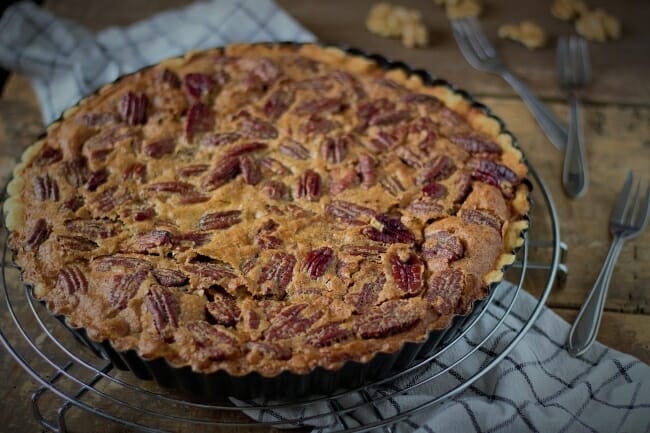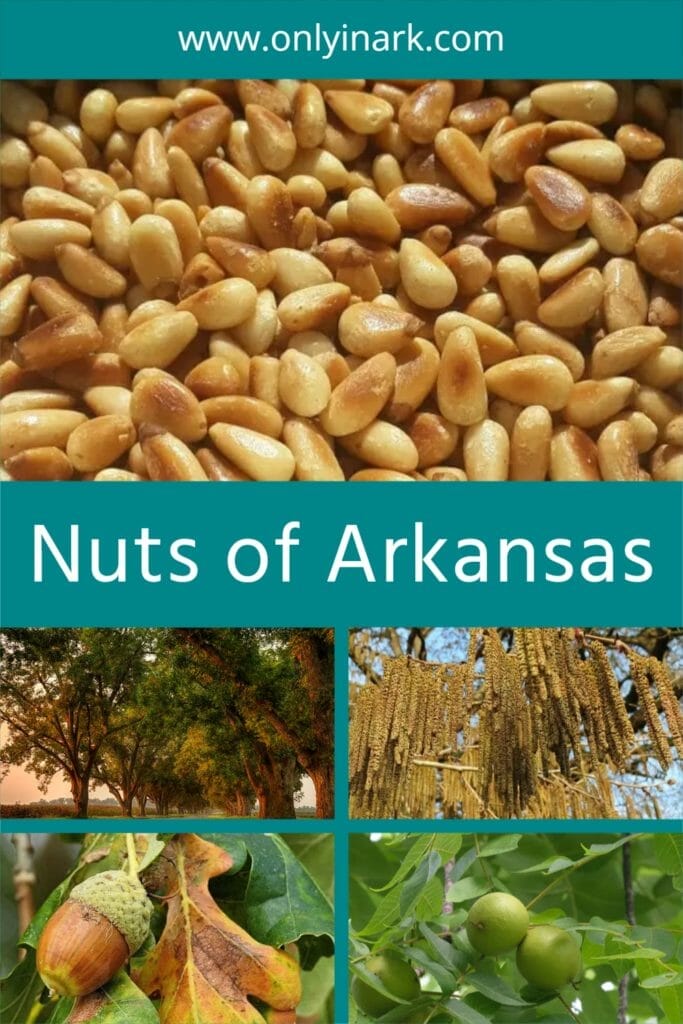

Uh oh...
It appears that you're using a severely outdated version of Safari on Windows. Many features won't work correctly, and functionality can't be guaranteed. Please try viewing this website in Edge, Mozilla, Chrome, or another modern browser. Sorry for any inconvenience this may have caused!
Read More about this safari issue.
Scott Pecan Trees

There are a lot of nuts in Arkansas. I’m not talking about your neighbor down the road, but the type that grows in trees across the state. Arkansas is known as the Natural State, and what’s more natural than food that grows on its own and only needs to be foraged or purchased from a local grower to enjoy? Nuts were part of the diet for Native American tribes and early Arkansas settlers, and today they still offer plenty to munch on. These seven nuts grow around the state and feed wild animals, are foraged and sold, or are grown locally to provide Arkansas with a nutty experience.

Oak Acorns
Oak trees produce acorns, and Arkansas has plenty of both. There are over 450 species of oak trees in the world, with 85 of these in the United States. Arkansas has around 30 different species of oak. Oaks are separated into two main categories: red oaks and white oaks. They drop their acorns in the fall, with the peak for acorns from October to November.
Acorns vary in size according to the age of the oak and its species. Red oak acorns are typically smaller with caps that sit on top of the nut. White oak acorns are longer, and their caps stretch farther down the nut, especially burr oak acorns, which can cover over half the acorn with its fuzzy cap. Acorns are mostly eaten by squirrels, deer, and other wildlife, but they were once an important source of food for native tribes and early settlers in the state. Acorns can be ground into flour, used to make mush, eaten whole, and even used as a substitute for coffee beans.

American Hazelnut
The American Hazelnut, also known as the American Filbert, is found in the central and eastern parts of the U.S., with Arkansas in its southernmost range. It is a shrub that grows six to 12 feet tall. Its most noticeable feature is the catkins it produces in winter. These are long yellowish-brown seeds that hang from the shrub. It also produces an edible nut in abundance, and these are easily shelled. They’re found in the fall and can be eaten once the papery shell begins to pull back from the nut. Look for the shrub’s telltale heart-shaped leaves and those yellow catkins to locate the hazelnuts.

Black Walnuts
Black Walnut trees grow in northern Arkansas and are native to the Ozarks. The trees are typically not favored by gardeners because the roots release a toxin that kills or inhibits the growth of other plants nearby. The trees are large and produce green balls that drop in the fall and contain the harder black walnut inside. There is a black walnut harvest every fall, and foragers and landowners can transport them to a hulling center and be paid by the pound. Black walnut husks contain an oil that will stain clothes and skin. The walnut itself is rich and meaty, but cracking the walnut is not an easy task and usually requires either a special tool from a walnut hull center, or a hammer, so proceed with caution.

Chinquapin Nuts
The Ozark Chinquapin tree once grew prolifically in Arkansas, but the tree is related to the chestnut tree, and the same disease that killed most of these trees in the U.S. also affected the Ozark Chinquapins. They can now be found mostly as shrubs that grow in specific plots of land where the Ozark Chinquapin Foundation and Arkansas State Parks are trying to rejuvenate the native species. The tree is still affected by blight, which severely stunts its growth. It produces a nut covered in a prickly burr which eventually opens and releases the nut. The nut resembles a hazelnut in look and taste and was once a highly sought-after staple.

Hickory Nuts
Hickory nuts are another nut that is very common across Arkansas. They grow on a wide variety of hickory trees, from shagbark, pignut, water hickory and more. These trees grow well with oak trees and make up a large part of Arkansas’s hardwood forests. Hickory nuts drop in the fall as green ovals that eventually change to brown. They are tough nuts to crack, but they’re edible, although some varieties are bitter. Shagbark and mockernut are two varieties that taste good, and water hickory nuts are bitter.

Pine Nuts
Pine nuts aren’t actually nuts at all. They’re the seeds found in pinecones, and they are edible and delicious. Arkansas is full of beautiful evergreens; the pine tree happens to be the state tree of Arkansas. Loblolly pines are one of the state’s most prolific evergreens. Shortleaf and longleaf pines are also present across the state. All produce pinecones, and the pine nuts can be found underneath the scales of the cone. They’re ready to eat once the pinecone has dried out. If you’re foraging, the pinecones that have dropped are most likely dried out, but if you place them by a fire or in the oven it will hasten the process. Pinecones fall from trees during the fall and continue into winter.

Pecans
Perhaps the most famous nut in Arkansas is the pecan. The trees are native to Arkansas and grow across the central, southern, and eastern regions. Pecans are beloved for their taste and for their ease of shelling. The nuts are large, and their shells are easy to crack and pick out the nuts. Though trees do grow wild in Arkansas and in backyards, there are also pecan groves around the state where pecans are cultivated, harvested and sold locally. Pecans are also the official nut of Arkansas, and though pecan pie isn’t the state’s official dessert, it’s still a great choice for those Arkansas pecans.

Arkansas Nut Resources
Find a pecan grove near you by reading about Arkansas pecans.
If you’d like to try your hand at harvesting black walnuts, find all hulling and buying locations at Hammons Black Walnuts.
The story of how Arkansas State Parks and the Ozark Chinquapin Foundation are bringing back the Chinquapin tree was featured in National Geographic, and more information can be found at Arkansas State Parks or the Ozark Chinquapin Foundation.
Learn more about harvesting and eating hickory nuts from seriouseats.com.
Outdoor Life offers the Ultimate Guide to Foraging and Eating Acorns if you want to give it a try.
If you’re ready to bake the perfect pecan pie with your Arkansas pecans, try out these excellent recipes from Taste of Arkansas and Dining With Debbie.
Whether you forage nuts or leave them for Arkansas wildlife, purchase them or bake them, Arkansas nuts are a natural way to enjoy what the Natural State has to offer.
Photo of pecan trees in Scott, Arkansas courtesy of the Arkansas Department of Parks, Heritage and Tourism.
We do the work.
You check your email.
Sign up for our weekly e-news.
Get stories sent straight to your inbox!













 Leave a Reply
Leave a Reply
[…] Exciting World of Arkansas Mushroom Foraging More Than Meets the Eye: Weeds You Can Eat Nuts of Arkansas 10 Wild Edible Plants in […]